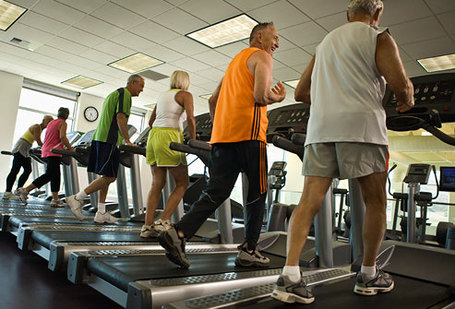the Awareness Through Movement
Do everything very slowly
I do not intend to "teach" you, but to enable you to learn at your own rate of understanding and doing. Time is the most important means of learning. To enable everybody-without exception-to learn, there should be plenty of time for everybody to assimilate the idea of the movement as well as the leisure to get used to the novelty of the situation. There should be sufficient time to perceive, and organize oneself. No one can learn when hurried and hustled. Each movement is, therefore, allotted sufficient time for repeating it a number of times. Thus, you will repeat the movement as many times as it suits you during the span of time allotted.
When one becomes familiar with an act, speed increases spontaneously, and so does power. This is not so obvious as it is correct.
Efficient movement or performance of any sort is achieved by weeding out, and eliminating, parasitic superfluous exertion. The superfluous is as bad as the insufficient, only it costs more.
No one can learn to ride a bicycle or swim without allowing the time necessary to assimilate the essential, and to reject the unintended and unnecessary, efforts that the beginner performs in his ambition not to feel or appear inadequate to himself.
Fast action at the beginning of learning is synonymous with strain and confusion which, together, make learning an unpleasant exertion.
Look for the pleasant sensation
Pleasure relaxes the breathing to become simple and easy. Excessive striving-to-improve impedes learning. It is less important to learn new feats of skill than it is to master the way to learn new skills. You will get to know new skills as a reward for your attention. You will feel you deserve your acquired skill, and that will add satisfaction to the pleasurable sensation.
Do not "try" to do well
Trying hard means that somehow a person knows that unless he makes a greater effort and applies himself harder he will not achieve his goals. Internal conviction of essential inadequacy is at the root of the urge to try as hard as one can, even when learning. Only when we have learned to write fluently and pleasurably can we write as fast as we wish, or more beautifully. But "trying" to write faster makes the writing illegible and ugly. Learn to do well, but do not try. The countenance of trying hard betrays the inner conviction of being unable or of not being good enough.
Do not try to do "nicely"
A performance is nice to watch when the person applies himself harmoniously. This means that no part of him is being directed to anything else but the job at the hand. Intent to do nicely when learning introduces disharmony. Some of the attention is misdirected, which introduces self-consciousness instead of awareness. Each and all the parts of ourself should cooperate to the final achievement only to the extent that it is useful. An act becomes nice when we do nothing but the act. Everything we do over and above that, or short of it, destroys harmony.
These courses are made to help you to turn the impossible into the feasible, the difficult into the easy: beautiful to see and lovely to do.
Insist on easy, light movement
We usually learn the hard way. We are taught that trying hard is a virtue in life, and we are misled into believing that trying hard is also a virtue when learning. We see, therefore, a beginner, learning to ride a bicycle or to swim or to learn any skill, making many futile efforts and tiring quickly.
Learning takes place through our nervous system, which is so structured as to detect and select, from among our trials and errors, the more effective trial. We thus gradually eliminate the aimless movements until we find a sufficient body of correct and purposeful components of our final effort. These must be right in timing and direction at the same instant. In short, we gradually learn to know what is the better move. Thus it dawns on us that moving the handlebar so as to twist the front wheel in the direction in which we tend to fall stabilizes us on the bicycle. Or that if we move our arms and legs slowly forward in the swimming direction and rapidly in the other direction we actually swim easier and faster. We sense differences and select the good from the useless: that is, we differentiate.
Without distinguishing and differentiating, we perpetuate-and possibly fuse-the good and the bad moves in a haphazard order as they happen to occur and make little or no progress in spite of diligent insistence.
It is easier to tell differences when the effort is light
All our senses are so built that we can distinguish minute differences when our senses are only slightly stimulated. If I were to carry a heavy load (say a refrigerator) on my back, I could not tell if a box of matches were added to the load, nor would I become aware of it being removed. What is, in fact, the weight that must be added or removed to make one aware that some change of effort has occurred? For muscular efforts or our kinesthetic sense, that weight is about one-fortieth (1/40) of the basic effort for very good nervous systems. On carrying 400 pounds, we can tell at once when 10 pounds are added or removed from the load. On carrying 40 pounds, we can tell a change of one pound. And everybody can tell with closed eyes when a fly alights on a thin matchlike piece of wood or straw, or when it takes to the air again.
In short, the smaller the exertion, the finer the increment or decrement that we can distinguish and, also, the finer our differentiation (that is, the mobilization of our muscles in consequence of our sensations). The lighter the effort we make, the faster is our learning of any skill; and the level of perfection we can attain goes hand in hand with the finesse we obtain. We stop improving when we sense no difference in the effort made or in the movement.
Learning and life are not the same thing
In the course of our lives, we may be called upon to make enormous efforts-sometimes beyond what we believe we can produce. There are situations in which we must pay no heed to what the enormous effort entails. We often have to sacrifice our health, the wholeness of our limbs and body, to save our life. Obviously, then, we must be able to act swiftly and powerfully. The question is, wouldn't we be better equipped for such emergencies by making our efforts efficient in general, thus enabling us to exert ourselves less and achieve our purpose economically.
Learning must be slow an varied in effort until the parasitic efforts are weeded out; then we have little difficulty in acting fast, and powerfully.
Why bother to be so efficient?
We need not be intelligent, for God saves the fool. We need not be skillful, for even the clumsiest of us succeeds in the end. We need not be efficient, because a kilogram of sugar yields-roughly speaking-20.000 calories, and one gram calorie produces 426 kilograms of work. From that count, we can waste energy galore. Why go to such troubles as learning and improving? The trouble lies in that energy cannot be destroyed; it can only be transformed into movement, or into another form of energy.
What, then, happens to the energy that is not transformed into movement? It is, obviously, not lost, but remains somewhere in the body. Indeed, it is transformed into heat through the wear and tear of the muscles (torn muscles, muscle catarrh) and of the ligaments and the interarticular surfaces of our joints and vertebrae. So long as we are very young, the healing and recovery powers of our bodies are sufficient to repair the damage caused by inefficient efforts, but they do so at the expense of our heart and the cleansing mechanisms of our organism. But these powers slow, even as early as at our middle age, when we have only just become an adult, and they become sluggish very soon thereafter
If we have not learned efficient action, we are in for aches and pains and for a growing inability to do what we would like to do.
Efficient movement is also pleasant to do and nice to see, and it instills that wonderful feeling of doing well and is, ultimately, aesthetically satisfying.
Do not concentrate
Do not concentrate if concentration means to you directing your attention to one particular important point to the utmost of your ability. This is a particular kind of concentration, useful as an exercise, but rarely in normal occupation and skills.
Suppose you play basketball and concentrate on the basket to the utmost-you will never, or nearly never, have the leisure to do so unless you are alone in front of the basket. When there are two teams playing, the opening for a throw is a short, fleeting instant in which you have to attend not only to the basket, but to the players around you, and to the balance and posture that enable you to perform a useful throw.
The best players are those who attend to the continually changing position of their own players as well as of the opposing team. Most of the time, their concentration is directed to a very large area or space; the basket is just kept dimly in the background of their awareness, from where it can- at the most fleeting opportunity-become the center of attention.
The best and most useful attention is similar to what we do when reading. When we see the whole page, we cannot perceive any of the content, although we can say whether the page is in English or some language we cannot read. To read, we must focus on a minute portion of the page, not even a full line-perhaps, merely a single word, if it is a familiar one and rather short. If we are a skillful reader, we keep on picking our word after word, or groupings of words, to be attended to by our macular vision, which is only a minute portion of the retina, with sufficient good resolution to see small print clearly.
The good way of using our attention is, for the most part, similar to reading. One should perceive the background (the whole page) dimly and learn to focus sharply on the point-attended (concentration) rapidly before the next so that reading fluently means reading 200 to 1000 words a minute, as some people can.
Therefore, do not concentrate but, rather, attend well to the entire situation, your body, and your surroundings by scanning the whole sufficiently to become aware of any change or difference, concentrating just enough to perceive it.
In general, it is not what we do that is important, but how we do it. Thus, we can refuse kindly and accept ungraciously. We must also remember that this generalization is not a law and, like other generalizations, it is not always true.
We do not say at the start what the final stage will be
We are so drilled or wired-in by prevailing educational methods that when we know what is required of us, we go all-out to achieve it, for fear of loss of face, regardless of what it costs us to do so. We have it instilled in our system that we must not be the worst of the lot. We will bite our lips, hold our breath, and screw up our straining self in an ugly way in order to achieve something if we have no clear idea of how to mobilize ourselves for that task. The result is excessive effort, harmful strain, and ugly performance. The Awareness Through Movement® lessons will help you to reach your inborn potentiality in the best way and avoid giving you just another opportunity for using yourself in the accustomed way which led you, initially, to seek a better one.
By reducing the urge to achieve, and attending also to the means for achieving, we learn easier. Achieving-we lose the incentive for learning and, therefore, accept a lower level than the potential we are endowed with. When we delay the final achievement by attending efficiently to our means, we set ourselves a higher level of achievement if we are not aware that that is what we are doing. On knowing what to achieve before we have learned to learn, we can reach only the limit of our ignorance, which is often general. Such limits are intrinsically lower than those we can foresee after knowing better.
Do a little less than you can
By doing a little less than you really can, you will attain a higher performance than the one you can now conceive. Do a little less than your utmost while learning. You are thereby pushing your possible record to a higher setting.
Suppose you have not been running for a few years or that you are a middle-aged adult with the usual spread that goes with it: Suppose that you want to do some running again, and set out to the speed you remember: You will soon find yourself out of breath, your heart pounding, and compelled to stop, only to find that you have not achieved what you intended to achieve. Moreover, you will most likely be stiff all over and find it very difficult to persist in what you set out to do.
Now suppose you make your first attempt a little less fast than the top speed that is possible for you at this moment and, looking at your watch, you find that you are short of what you used to be able to do: But you will feel and think you could have done a little better had you really tried your best: This feeling will lead you to try again. The next attempt will be a little faster anyway, so that, continuing to do a little less than your utmost, you go on improving. In the end, you will in a short time give a better account of yourself than in your younger days when youthful stamina and ambition made you always do your utmost. The wisdom of doing a little less than one really can pushes the record of achievement further and further as you come nearer to it, similar to the horizon that recedes on approaching it.
You will understand now why I say in the lessons "lower your knees in the direction of the floor" rather than "try to touch the floor with your knees." This makes no difference to anyone who is beyond improving; but you will convince yourself that it makes a real difference, reminding you to keep yourself out of stress and give yourself a real chance to learn to learn.
©Feldenkrais Resources, Berkeley, CA























